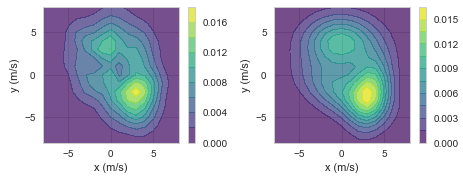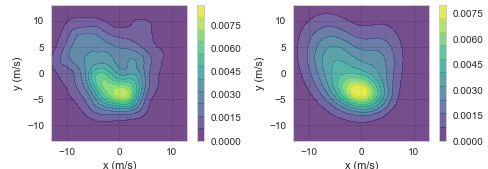A Probability Model for the Joint Distribution of Wind Speed and Direction (Gaussian Mixture Models, GMM)
What is this?
This is a Python program for modeling the joint distribution of wind speed and direction.
The method is based on:
-
Harris, Cook, The parent wind speed distribution: Why Weibull?, http://www.sciencedirect.com/science/article/pii/S0167610514001056
-
Gaussian Mixture Models, http://scikit-learn.org/stable/modules/mixture.html
Fitting Effect
Take Shanghai Hongqiao Intl as an example
1. PDF (Probability Density Function) Comparison
Left: Empirical PDF, Right: Model PDF
2. Speed and Direction Distribution Comparison
Histogram vs. Model
3. Sectoral Comparison
Left: Histogram vs. Model, Right: Empirical vs. Model CDF
4. Live Demo
The above results are available at https://cdn.rawgit.com/cqcn1991/Wind-Speed-Analysis/master/output_HTML/hongqiao_intl.html , along with other analysis.
Application
This model can be used to obtain the wind speed distribution, wind direction distribution and the joint distribution of wind speed and direction distribution with good accuracy.
Its potential applications include:
-
Wind energy evaluation, wind resource assessment (long term). For example, the optimization of wind farm layout.
-
Wind load analysis on structures, such as fatigue analysis. For example, the wind load on highrise buidings.
-
Pedestrian-level wind environment assessment.
Gallery
Here is how the method applies to different places across the world. The Weibull distribution is listed as the traditional model for comparison.
1. North America
Minneapolis, USA
Boston 16 NM East, USA (Offshore)
2. Europe
Tiree, UK
Pau Pyrenees, France
Landsberg Lech, Germany
3. East Asia
Luogang, China
4. Mid East
Al Maktoum Intl, United Arab Emirates
You can use the code toggle button and sidebar to navigate these reports.
The Probability Model
The model I'm using is Gaussian Mixture Model, or simply put, the sum of some normal distributions. The idea is very simple:
1. For a certain wind character, the wind vector (speed and direction) follows the normal distribution:
2. For specific location, its wind speed direction distribution is composed of several such wind characters, and hence the sum of several normal distributions:
fi is the PDF of normal distribution component, pi is its weight.
The chief beauty of this model is its elegance (simplicity). You can use such a simple model (GMM) to describe wind, contrary to previous Weibull combination and others.
For a complete explanation of how GMM fit the joint distribution of wind speed and direction, you can read
Harris, Cook, The parent wind speed distribution: Why Weibull?, http://www.sciencedirect.com/science/article/pii/S0167610514001056
And I'm also working on a paper about it, this is my Master Thesis. And if you have any interest (question, collaboration...) feel free to ask me. I open source the project is meant to help you try it.
How to use it
1. Install Anaconda
Download at https://www.continuum.io/downloads
This repo use Python 3, so you should use the 3 as well.
2. Additional Environment Configuration
After installing Anaconda, there are still some additional packages you need to install:
Just run these in your command line to install them
pip install -r requirements.txt
3. Download the current repo
4. Start Jupyter Notebook, open the GMM.ipynb, and start playing with it
You may need some datasets to get started. For this reason, I have include some in https://github.com/cqcn1991/Wind-Speed-Analysis/tree/master/data If you want additional data, you can find them at http://www.ncdc.noaa.gov/
If you have any question, you could post it at issue, or mail me at 38306608#qq.com
Acknowledgement
This work would be impossible without the help from Cook and Harris. Thank you!



















